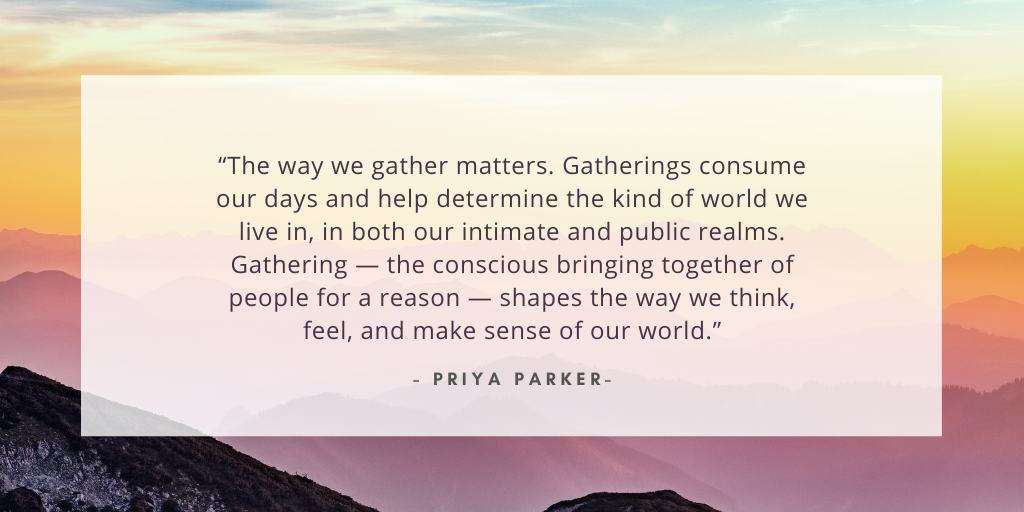As student affairs professionals, our entire careers are built around the idea that moments of greatness can happen when we find community and build connections with others.
In a normal year, it’s helpful to reflect on the ways in which we create those experiences for our students. But as 2020 isn’t a normal year, meaningful connections are perhaps more important now than ever before.
Much has been written about moving the student experience online. At this point, we could all probably give a TED Talk on how to make sure a Zoom meeting doesn’t flop. But as we look to virtually engage with colleagues and students, we can’t only hope not to flop; we’ve also got to thrive.
In her book The Art of Gathering: How We Gather and Why It Matters, Priya Parker outlines tips for intentionally designing meetings, retreats, conferences, birthday parties, or any other group gathering to ensure that you meet your goals while also facilitating meaningful connections.

How do we do this through laptops and phone screens? Fortunately, there is much that we can learn from Parker’s strategies and apply to our virtual settings. We just have to get a bit creative.
The book outlines eight key considerations. I’m going to focus on the three that are most relevant to us as higher education professionals, but a summary of all eight tips can be found towards the end of this post.
Decide why you’re really gathering
We’ve all been a part of meetings that we didn’t actually need to have. Whether the meeting could have been an email, could have benefited from everyone doing prep work beforehand, or has been recurring since before you took the job, it needs a real purpose to be worth your time. And the way you prepare for, lead, and follow-up after that meeting needs to be in line with that purpose.
For example, imagine you have a regularly scheduled meeting with a group of students who were planning a recently canceled program. You probably don’t want to waste their time with a frivolous meeting now when their world has been turned upside down. Yet, you know that everyone is looking for some consistency and connection right now, even from afar. So, deciding to meet might still be smart — if you’ve drilled down and assessed precisely why you’re still bringing your students together.
If your meeting’s new set purpose is to help students feel connected, then consider facilitating a discussion on how everyone is coping with virtual engagement or staying motivated via virtual learning. Allow students to share their perspectives out loud or type in the chatbox. You could even split them into breakout rooms with specific discussion points — some light and some challenging.
Alternatively, if the purpose of your meeting is to finalize transition documents and capture the great ideas that sadly won’t (yet) see the light of day, then ask students to discuss what they hoped to accomplish.
Both of these provide justification for intentional gatherings. One thing you should never do is ask students or colleagues to join a virtual meeting merely because it’s on the calendar. Zoom fatigue is real, and the only thing more exhausting than engaging in multiple virtual conversations is engaging in pointless virtual conversations.
So, evaluate your true purpose, then stick to it.
Don’t be a chill host
Parker stresses that too many event hosts tend to think it’s helpful to take a laid-back, hands-off approach. But, that’s usually not the best tactic. If you leave it up to participants to wonder what’s going on or take control of the experience, you won’t get the results you’re looking for.
Student affairs professionals are often tempted to let an event flow organically. This is because we have all participated in gatherings that were too rigid, wherein connections felt forced or the agendas felt like to-do lists. We know there should be more life to a program, so we loosen up the reins and expect the magic to happen on its own.
The problem, though, is that loosening the reins too much gives the power — which includes your intended goals and experiences — away to the group. As Parker points out, when the absence of clear leadership and direction is felt among the group, someone will naturally take over to fill the void.
The result will be awesome if one of your students really shines and leads the experience to a meaningful place organically. But, it could be quite miserable if the wrong person takes the lead, or if the presence of uncertainty and discomfort causes everyone to withdraw.
So, in addition to understanding the purpose of your gathering, you must commit to executing all the small details that’ll bring it to life. Whether you facilitate these pieces yourself or you delegate some tasks to student leaders, be sure that you have a solid plan in place. Your reflection questions, activities, and small group discussions — these all serve a purpose; you shouldn’t just roll past them in an effort to make the group feel more comfortable. In fact, it might have the opposite effect.
Committing to a strong facilitation plan is even more vital for virtual experiences. The days of organic small-talk turning into something powerful and unexpected are waiting for us on the other side of this, but they aren’t really on the table now. So, plan the agenda for your experiences intentionally and be detailed.
Train a few students or colleagues or tap them to chime in to keep the conversation flowing. Own the experience. Lean into the fact that your energy and direction are vital for facilitating interpersonal connections.
Create a temporary alternative world
I’ve never related to the movie Groundhog Day more than I do now. Besides the flavor of LaCroix I have on hand each week, nothing ever changes.
Our colleagues and our students are feeling this monotony, too. So, let your virtual event feel like a temporary trip to another world. Parker offers a few tips that can help you do so.
First, remember that the experience begins from the moment you invite guests. Your messaging about what is happening, what to expect, and how to prepare should all be designed to give participants a preview of the upcoming program.
What mindset do you want them to come in with? What work should they do or prepare beforehand? Do you want to inspire anticipation for an exciting bonding experience? Plant these seeds in the lead-up via your marketing and communication. In Zoom times, this could be as simple as a message in your calendar invite, a fun graphic, a link to a video, or a small box of goodies mailed to your staff.
Next, you should create a set of rules for your alternative world. Whether your gathering is a one-time leadership experience or a weekly staff meeting, establish a few rules that everyone agrees to for the duration of the experience.
Involving participants in the creation of these rules at the first gathering is a great way to solicit buy-in and inspire creativity. This will create a sense of trust and boundaries, prevent resentments, and provide consistency for attendees. Participants will know what to expect and can relax a bit once you’ve unveiled some unknowns.
These rules could be logistical, like keeping your cameras on and phones off when joining from a computer. Or, they can relate to engagement, like that the meeting won’t start until everyone shares the best thing that happened to them that week.
You could also invoke rules related to the environment you hope to create. For example, you could ask a different student each week to kick off the gathering with their favorite party song. Parker loves asking everyone to share a personal story, requiring whoever goes last to sing theirs. This gives the participants an incentive to engage and lean in.
All 8 Tips
A short summary of each of Priya Parker’s tips is below. Her book is well worth the read for anyone dreaming about the magic of bringing people together.
1. Decide why you’re really gathering. Drill down deep and identify the reasons you’re actually bringing people together. You can’t do everything in one meeting.
2. Close doors. No event is created for everyone, and that’s ok. The more specific your audience and your goal, the more successful your outcome will be.
If you really just need to plan virtual Greek Week, you don’t need your entire engagement board present. If what you really need is a space for students of color to connect, you don’t have to market the gathering to anyone else.
3. Don’t be a chill host. Don’t be so laidback that your presence isn’t noticed. Be intentional about your goals and create the experience you set out to create.
4. Create a temporary alternative world. Add whatever special details or rules you can to make your time together feel like a totally different place wherein magic can flourish.
5. Never start a funeral with logistics. The most important moments in a gathering are the very beginning and the very end.
In the beginning, you have everyone’s attention, and they are still hopeful that what you have for them is exciting and worth it. With that in mind, don’t open with an overview of the agenda. Use that time to welcome everyone energetically, remind them of the goals of the gathering, and share the learning outcomes you hope they gain from the experience before diving into details.
The end of the gathering is your chance to create an opportunity for reflection among the participants, allow them to create an action plan, and wrap up your experience with a meaningful bow. Don’t allow attendees to leave without a powerful closing that ensures they remember what they learned!
6. Keep your best self out of my gathering. The goal of a gathering usually involves connecting people in an authentic way in order to foster meaningful changes, an exchange of ideas, and interpersonal bonding.
If you have your most polished, networking-friendly personality on display, everyone will feel the need to keep their guards up. Leave the titles and resumes at home and connect as humans. It’s great to be professional, but be sure to let your guard down and get to know the people going through this experience with you.
7. Cause good controversy. Don’t bring people together and waste their time by merely agreeing on everything you already knew before showing up. If there is a decision to be made or change to brainstorm through, find ways to push boundaries and inspire innovation!
8. Accept that there is an end. You shouldn’t avoid the sadness and formality of concluding an event just because you want to cling to the excitement it brought everyone. Taking the time to close out and encourage intentional reflection and action steps enables participants to truly process what they learned.
Close out the experience in a meaningful way that captures what you shared together, perhaps by creating an action plan or sharing key takeaways with other participants.

There are many ways we can make good use of the virtual time we have together. It is vital to your students’ mental health, as well as their personal and professional growth, to find some ways to make this world work for a little bit longer. Be creative, don’t be afraid to try and fail, and be intentional about your gatherings.
How have you designed intentional gathering spaces? Connect with us on Twitter @themoderncampus and @ShaunaJPrentice.





